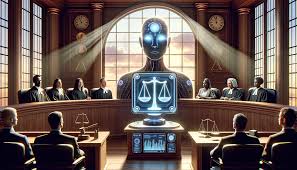INTRODUCTION
In recent years, artificial intelligence (AI) has moved from science fiction to courtroom reality. From predicting case outcomes to drafting contracts and summarizing judgments, AI is rapidly transforming how lawyers and judges work. In India and around the world, the legal system is now asking a crucial question can technology deliver justice without compromising fairness and ethics?
THE RISE OF AI IN LEGAL PRACTICE
AI has quietly become a powerful assistant in the legal field. Legal research tools such as Manu Patra AI, SCC Online AI Assist, and ChatGPT-style applications are helping lawyers find case laws in seconds. Courts in India are also experimenting the Supreme Court’s e-courts project aims to digitize and streamline processes, while some High Courts have begun using AI-based translation tools to make judgments available in local languages.
Globally, countries like the United States and the United Kingdom are using AI for tasks like reviewing evidence, assessing risk in bail decisions, and even predicting recidivism. These developments show that AI can enhance efficiency and reduce human error. However, they also raise a pressing concern can we trust machines to make decisions about human lives and rights?
ETHICAL CONCERNS: BIAS AND TRANSPARENCY
One of the biggest ethical challenges in using AI in the courtroom is bias. AI systems learn from data, and if that data reflects social or historical discrimination, the algorithm may replicate it. For example, an AI trained on biased criminal records may unfairly label individuals from certain communities as “high risk.” This violates the constitutional principle of equality before the law.
Another issue is transparency. AI often functions as a “black box” it produces results without explaining how it reached them. In the justice system, where reasons and accountability are essential, such opacity can undermine trust. If an AI tool recommends denying bail or predicts guilt, both the accused and the judge have the right to know how that conclusion was reached.
ADMISSIBILITY OF AI-GENERATED EVIDENCE
A legal dilemma also arises regarding the admissibility of AI-generated evidence. Can an AI report, transcription, or prediction be presented as valid evidence? Indian courts currently lack clear guidelines. While the Indian Evidence Act recognizes electronic evidence, it was not designed with machine learning or autonomous systems in mind. Questions of authentication, accuracy, and human oversight remain unresolved.
Moreover, AI tools may be manipulated or produce results based on flawed data. In such cases, determining liability whether it rests with the developer, the user, or the system becomes a grey area. These issues call for urgent legal reform to define how AI evidence can be used and challenged in court.
THE LAWYER’S ETHICAL DUTY IN THE AGE OF AI
For lawyers, AI offers both convenience and caution. It can save hours of research and drafting time, but overreliance on it may lead to ethical lapses. The Bar Council of India emphasizes that lawyers must use technology responsibly and ensure confidentiality of client data. If a lawyer uses AI-generated content without verifying its accuracy, they risk misleading the court which could amount to professional misconduct.
AI tools can assist but not replace human judgment. Legal reasoning involves empathy, morality, and discretion qualities that no algorithm can truly replicate. Thus, the lawyer’s role must evolve to include technological literacy while maintaining the traditional values of diligence, integrity, and independence.
THE WAY FORWARD: REGULATION AND RESPONSIBILITY
To ensure AI serves justice and not convenience, a balanced regulatory framework is essential. India does not yet have a specific law governing AI use in courts or law firms. However, principles from the Digital Personal Data Protection Act, 2023, and the Information Technology Act, 2000 can guide responsible data handling.
The government’s proposed National Strategy on Artificial Intelligence also emphasizes ethical AI focusing on transparency, accountability, and inclusivity. For the legal sector, this means developing clear guidelines on AI use, mandatory human oversight, and safeguards against data misuse. Training programs for judges and lawyers on AI literacy could also bridge the gap between technology and law.
CONCLUSION
Artificial intelligence is no longer a distant concept; it is already reshaping the courtroom. When used wisely, it can speed up justice, reduce backlog, and enhance access to legal information. But when used blindly, it risks eroding fairness, privacy, and accountability the very pillars of the justice system.
As India steps into this new era, the challenge is not to resist AI but to regulate it responsibly. The future of justice must remain human at its heart, with AI as a tool not a judge.
CONTRIBUTED BY: SWEETA NAMASUDRA (Intern)

